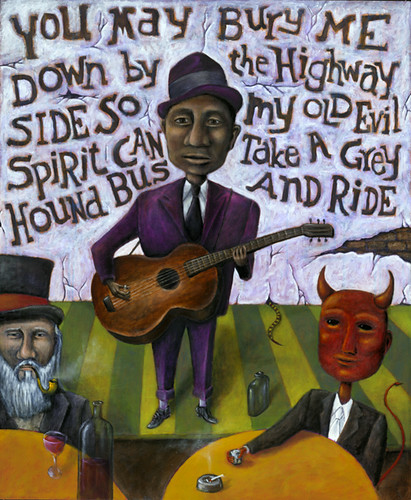All Encompassing Theories
June 2nd, 2011
I do too much thinking. Perhaps I should have been a philosopher, but I don’t want to live in the streets like Diogenes. I need income, quite badly really. So I sometimes wonder if all the time I spend thinking, I should be spending doing something else. Ditto for blogging.
Regardless, over the last decade or so I’ve come up with no less than three all encompassing theories, or if not all encompassing at least grand or perhaps grandiose. Who knows I might have come up with more, but three of them have coalesced sufficiently in my damaged mind that I can write about them with some conviction. One was developed on this blog about writing. One I may have alluded to the existence of in a postcard or letter. And the third is a result of years of listening to music and playing guitar alone at night.
I’d say most all encompassing theories come from lots of time spent alone at night. I don’t think many of the world’s great thinkers or writers were happily married for fifty years.
Theory One: Timelessness & Timeliness
This theory on writing or even expanded to other artforms has been detailed considerably on Muskblog. Succinctly the two most important qualities to strive for in writing are timelessness and timeliness. Rarely does a a single work exude both in sufficient degree. The example I gave which did was “A Modest Proposal” by Samuel Taylor Coleridge.
Underlying both timelessness and timeliness is quality, or Quality with a capital Q if you prefer. The two writers/thinkers that have expounded extensively on this or at least influenced my thinking are: Robert M. Pirsig and Fredrich Nietzsche. The two books you should read are:
Theory Two: Concentric Circles of Coolness
This theory was developed while I lived in Germany. I spent my nights alone lying on the floor listening to Townes Van Zandt and reading folks like Nietzsche and Voltaire. I actually did a lot of the reading on the train, but I also did a lot of writing in journals while abroad. Some of the quotations I’ve collected came from my journals. Once, I went through something like ten years of journals looking specifically for quotations. I even published verbatim an excerpt or two from my journals which amused at least one of my Sauder MBA classmates.
Imagine societal consciousness as the flat surface of a pond or better yet an ocean, water everywhere, in all directions. The surface of the water represents our collective unconsciousness or more truthfully our collected beliefs in what is influential or cool in popular culture or some sphere. Consider just music, popular music say from the 1940s onward when recorded music become commercially viable for mass consumption. An artist or even a song or an album is a pebble dropped in the ocean. It can make a bigger or smaller splash depending on its immediate influence. And out from that initial impact point go concentric circles of waves. How long they ripple for and how far they travel is often unknown as perhaps few are there to observe the initial impact. Some crash hard with a loud and violent collision, others make a small initial impact but the ripples reverberate far and for a long period of time.
That’s the theory in brief. Someone makes an impact upon public perception. They could flame out or become unimportant quickly or their influence could grow over time. As the ripples collide that interaction is one of possibly mutual influence or if one force is stronger it absorbs and overcomes the other. Don’t think too hard on the physics of it. Just consider the Beatles arriving on the music scene or the Velvet Underground. There was Beatlemania versus very few people actually witnessing the Velvet Underground play live. Both bands’ ripples went on to interact with many other musicians and artists and can still be felt today. Or consider James Dean and Marilyn Monroe. Both died young and few people watch their movies today, but their influence on popular culture, our collective psyche, on what is considered cool remains.
Again there is a timelessness to great music and in popular music there is definitely a timeliness, whether it is topical folk songs or novelty songs, or songs about a particular dance or even scene. What is cool changes over time. Yet some things remain cool and sometimes things become cool again. I tried to encompass this all with my theory on the size of pebble dropped into the water, the height from which it was dropped, the intensity of the impact, and the length and time the ripples are felt.
It probably needs a bit more refinement but I haven’t thought about it much since 2001. It works for authors and books too. Some writers have a huge debut novel and never again achieve greatness, others go ignored and largely unread in their lifetime. Examples of both cases abound. The history of the written word is much longer than that of musical performance. Lots of computer algorithms exist now to measure influence from Klout to Apple’s Genius feature both are attempting to measure the size of the impact and the length the ripples travel and how fast and how strongly the concentric circles expand though I’m not sure they’ve modeled things quite like I envisioned.
In Germany late at night I wasn’t concerned with the mathematics of the model, I was more concerned with how all encompassing the insight was, which until now I’ve not shared. Perhaps if I’d self-published sooner I could sue. I still have the original journal which clearly dates when I recorded the idea. They can date ink somehow.
Theory Three: The Monoriff
There is a definite nod to Joseph Campbell and the Hero of a Thousand Faces in the title of this theory, but it has little to do with anthropology or the evolution of human societies and more to do with the limited number of musical notes, chords, progressions, and scales. In brief certain melodies or even more primal-y riffs exist and though people arrive at them from different sources, perhaps unaware of the originator of the riff, they none the less sense the rightness or the quality inherent in the riff.
I’ve dubbed these right, high quality, almost primal riffs, monoriffs. I’m not sure how many of them exist, but over the last few years I’ve been tracing the lineage of a few and through experimentation learning them on the guitar. There can’t be too many of them, every three or four chord progression is not a monoriff. A monoriff has to be of such Quality that it is timeless. It’s influence and coolness is far reaching and long lasting.
All three of my all encompassing theories are mutually compatible. Consider again popular recorded music since the 1940s particularly guitar based music which basically means: the blues, country, rock, and their derivatives. In my mind the blues is the root of popular North American music. Country comes from folk traditions and has European roots, whereas the Blues comes from Africa where the guitar originated. It was the influence of black musicians on both the guitar and the piano that gave the world Elvis, Sun Records, and rock and roll.
History is important to the monoriff. Who invented a riff is hard to tell, as some predate popular music on record or in sheet music form. Plenty of great musicians have difficulty reading and writing sheet music, yet they know what is good and right, what has Quality, what is timely, what is timeless. It is these timeless riffs that you know you’ve heard before and can find examples of them in many songs by many artists whether on the guitar or on another instrument most likely the piano, these are the monoriffs.
They come from the blues, from Africa, from some primal centre of the human brain or psyche. Just like the monomyth there is a timelessness and a long lasting influence which the more you investigate, the more you find proof of. Sampling is further proof of the existence and influence of the monoriffs, though often samples are not of guitar parts, the idea is the same; high Quality and timeless.
Book deal now please.
Google gets Circles
It appears someone has taken my basic idea and made it into a product/algorithm, that someone, Google Inc. They have circles and ripples in Google+. I never realized this until reading an article on Google+, can I claim prior art on a journal entry I wrote in 2002 but never published?
This entry was originaly posted on , it was last edited on and is filed under: Rambles and tagged: Philosophy, Timelessness, Timeliness.







It should go without explanation that monoriffs are Dionysian. It also should be obvious what I think is more important in music. Passion over precision. I feel I’ve written that before. Eternal Return of the Same and all that.